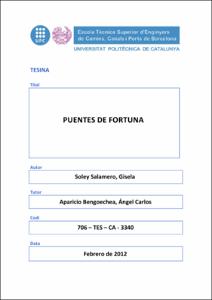Mostra el registre d'ítem simple
Puentes de Fortuna
| dc.contributor | Aparicio Bengoechea, Ángel Carlos |
| dc.contributor.author | Soley Salamero, Gisela |
| dc.contributor.other | Universitat Politècnica de Catalunya. Departament d'Enginyeria de la Construcció |
| dc.date.accessioned | 2012-03-06T13:46:35Z |
| dc.date.available | 2012-03-06T13:46:35Z |
| dc.date.issued | 2012-01-27 |
| dc.identifier.uri | http://hdl.handle.net/2099.1/14536 |
| dc.description.abstract | Castellà: El acceso a servicios tales como escuelas, hospitales, y centros comerciales suele ser una de las mayores prioridades en el desarrollo para muchas personas que viven en el medio rural. Las pasarelas de poca longitud se convierten entonces en un elemento que permite mejorar el acceso de estas gentes, reduciendo el tiempo de viaje a comunidades vecinas y mejorando su calidad de vida. De ahí la necesidad que se construyan estos puentes en zonas que realmente lo necesitan y donde el principal problema suele ser su financiación. Ante esta adversidad, es posible realizar un repaso de las diferentes tipologías estructurales y analizar ventajas y desventajas así como el uso de diversos materiales observando el que mejor se adapta a cada situación. De este modo se propone el tipo de puente que mejor se adapta a las condiciones descritas. De las tipologías estructurales que se estudian, puentes rectos, puentes arco, puentes pórtico y puentes sustentados por cables, destaca la simplicidad de los puentes rectos para luces pequeñas y los puentes colgantes por la eficiencia de su forma y por la posibilidad de ofrecer un paso permanente en caso de tener grandes luces. También es necesario considerar qué tipo de material se utilizará. La elección vendrá condicionada por diversos factores, entre ellos, la disponibilidad local, el coste y la facilidad de transporte al lugar, el número de trabajadores, controles de calidad disponibles, la seguridad, la durabilidad y las posibilidades que surgen para su financiación. Dentro de los criterios de selección, además de la tipología y del material disponible, también interesa conocer la luz, el tipo de tráfico al que está destinado, posibilidad de acceso a apoyo técnico tanto en el proyecto como en la construcción, y el crédito disponible. Cabe destacar, que existen diversas organizaciones que se dedican a ofrecer asistencia técnica en la construcción de puentes en zonas rurales de países en vías de desarrollo. Una vez finalizada la discusión, se proponen cuatro tipos de puentes que resultan fáciles de construir, éstos son: puentes de bambú, puentes de troncos, puentes de madera serrada y puentes colgantes. Y entre ellos, por su simplicidad tanto en su estructura como en su construcción destacan los puentes colgantes, cuyo análisis estructural se lleva a cabo en esta tesina. Cabe mencionar la comparación entre pasarelas de ‘ricos’ y pasarelas de ‘pobres’, observando algunos de los puentes peatonales más costosos del momento, frente a los puentes de bajo coste en las zonas que nos ocupan. De ahí que se genere el debate ante la relevancia que toman estos puentes en la actualidad, ya sea por su vertiente más artística, o por su carácter más funcional. |
| dc.description.abstract | Anglès: Access to facilities such as schools, hospitals and commercial centers are often one of the highest priorities in development for people who live in rural areas. The short span footbridges are likely to be an element which allows to improve the acces to this people, reducing the time it takes people to move other places, and consequently reaching other services and facilities they need. That’s why short span footbridges become an important element that allows improving the acces of population, reducing the time travelling to other communities and reaching other services and facilities. Therefore the need of building this kind of bridges in areas where they are really necessary and where the main problem is the budget and the financing programmes. To face this adversity, it is necessary to do an overview of the different types of framework and analyse the advantadges and disadvantages with different materials. Between the different types of frameworks studied, which are beam bridges, arch bridges, portico bridges and cable bridges, the simplicity of beam bridges can be outlined in case of having short spans and the cable bridges are the best choice in case of long span, because of the efficiency of its section. It is necessary to consider which kind of material might be used during the construction. The decisión will be conditioned by many different factors, for example the local availability, the quality controls available, security and endurance, and the different ways to receive a grant or any kind of financing. Other different points that have to be considered while making decisions are the bridge span, the load and the chance having technical assistance while designing and construction. In fact, there are some different organisations that work providing technical support in bridge construction in developing countries. Once the research is done, we can propose four types of bridges whose construction is not difficult: bamboo bridges, log bridges, wood bridges and suspension bridges. By the simplicity of its framework and of the construction, suspension bridges are one of the best options for projects in developing countries, and its analysis is carried out in this study. Finally, nowadays it seems impossible not comparing those footbridges erected in developed countries to those constructed in developing areas. The difference is huge and that’s |
| dc.language.iso | spa |
| dc.publisher | Universitat Politècnica de Catalunya |
| dc.rights | Attribution-NonCommercial-ShareAlike 3.0 Spain |
| dc.rights.uri | http://creativecommons.org/licenses/by-nc-sa/3.0/es/ |
| dc.subject | Àrees temàtiques de la UPC::Enginyeria civil::Geotècnia::Túnels i excavacions |
| dc.subject.lcsh | Bridges |
| dc.subject.other | pasarelas de poca longitud |
| dc.title | Puentes de Fortuna |
| dc.type | Minor thesis |
| dc.subject.lemac | Ponts |
| dc.rights.access | Open Access |
| dc.audience.educationlevel | Estudis de primer/segon cicle |
| dc.audience.mediator | Escola Tècnica Superior d'Enginyers de Camins, Canals i Ports de Barcelona |
| dc.audience.degree | ENGINYERIA DE CAMINS, CANALS I PORTS (Pla 1995) |


